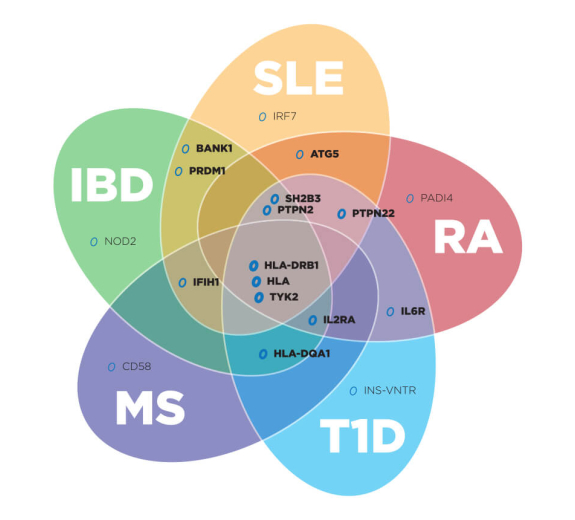Lauren Lippincott is not yet 35 years old, yet she lives with five autoimmune diseases. She’s not alone. About 25 percent of people with autoimmune diseases have a tendency to develop additional autoimmune diseases. For people who have more than one diagnosed autoimmune disease, it’s called polyautoimmunity. The combination of three or more diagnosed autoimmune disorders in one person is called Multiple Autoimmune Syndrome (MAS).
Scientists are investigating the exact reasons why people may get more than one autoimmune disease, but they agree that some of these diseases are linked through genetics and environmental causes, says Jane Buckner, MD, President of Benaroya Research Institute at Virginia Mason (BRI). “The gene defect that caused the immune system to attack the body and create an autoimmune disease could cause another autoimmune disease,” she explains.
BRI is a pioneer in understanding and discovering the commonalities between autoimmune diseases. “There’s a good reason that we say, ‘Progress against one autoimmune disease is progress against them all,’ ” emphasizes Dr. Buckner. “Underlying mechanisms in some of these diseases are similar, and as we figure out how one works, it gives us clues to how others work. As we more fully learn how the diseases operate, we can apply the right therapies to diagnose, treat, cure and ultimately prevent autoimmune diseases.”
Some diseases carry an increased likelihood of people having an additional autoimmune disease. These include rheumatoid arthritis, multiple sclerosis, autoimmune thyroiditis, Sjogren’s syndrome and others. Some diseases occur together more frequently, such as type 1 diabetes and celiac, because of a shared gene that predisposes for these diseases. In people who have three autoimmune diseases or more (MAS), researchers and physicians have identified groups of diseases that cluster together. This may be a helpful tool for doctors diagnosing additional autoimmune diseases in one person since there are more than 80 different disorders. As a practicing rheumatologist for instance, Dr. Buckner may see a patient with lupus or rheumatoid arthritis who also has Sjogren’s syndrome, these are common combinations of autoimmune diseases.
Be Alert for Symptoms
“While we don’t want people to worry about getting more than one autoimmune disease, we do want them to be alert for another one if symptoms do occur,” says Dr. Buckner. “Then they can be diagnosed and treated early on. Also, in some cases, the combination of diseases may require a change in medication.”
Some people may not realize that they have two or more autoimmune diseases because they are treated by different doctors for different things. For instance, a patient may have ulcerative colitis, which affects the gut, and see a gastroenterologist for care. Meanwhile she may also develop vitiligo, which affects the skin, and see a dermatologist for care. The patient might not be aware they are both autoimmune diseases. “It would be helpful for her to know that they are both autoimmune diseases and inform both of her doctors, so they can coordinate her care,” notes Dr. Buckner.
Parents of children with autoimmune diseases should also be alert to symptoms. “For instance, if a child with type 1 diabetes is losing weight and not thriving, he or she may have celiac disease,” says Dr. Buckner.
Multiple Autoimmune Diseases with Down Syndrome
BRI scientists are studying multiple autoimmune diseases in people with Down syndrome. “Patients with Down syndrome have a 15- to 100-fold greater chance of getting autoimmune diseases such as type 1 diabetes and celiac disease, and we want to understand why,” says BRI Principal Investigator Bernard Khor, MD, PhD. “We think it’s related to excessive DYRK1A, a protein that can prevent the body from shutting down unnecessary inflammatory responses. It is also a main gene in Down syndrome. If we’re correct, we might stop autoimmune diseases in these patients using DYRK1A inhibitors that are in development. Then we can go back to the broader patient populations with type 1 diabetes and other autoimmune diseases to understand who else might benefit from DYRK1A inhibition.”
To study this, BRI recently established the first Down syndrome biorepository in the Pacific Northwest, led by Dr. Khor and Rebecca Partridge, MD, head of the Virginia Mason Down Syndrome Program. Blood samples donated by participants with Down syndrome including those with and without autoimmune diseases, will be used to move research forward. Their parents and siblings can advance science by joining the Healthy Control Biorepository.




